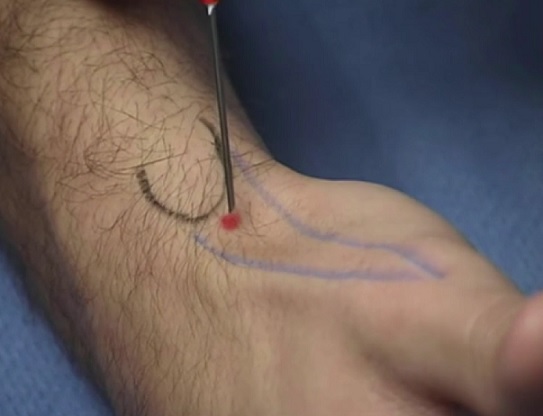Digital Nerve Block
Anatomy:
- The common digital nerves are derived from the median and ulnar nerves and divide in the distal palm into paired palmar branches. The nerves travel on either side of the flexor tendon sheath of each finger and innervate the lateral and palmar aspect of each finger. The smaller dorsal digital nerves, derived from the radial and ulnar nerves, run on the dorsal lateral aspect of each finger and supply sensation to the back of the finger.
Distribution of anesthesia:
- The digital nerve block provides anesthesia to the entire digit.
Technique:
- The surgical field should be prepared as close as possible to the metacarpophalangeal joint. While the procedure can be performed from either the volar or dorsal aspects of the digit; the later is less painful. Raise a wheal of anesthesia in the subcutaneous space and direct the needle palmar on both the medial and lateral aspect of the first phalange. To insure inadvertent vessel puncture, aspirate as you insert the needle. Apply one to two milliliters of anesthesia slowly as you are withdrawing the needle. Allow five to ten minutes for full anesthesia with lidocaine and fifteen to twenty minutes with bupivacaine. If this procedure does not provide complete anesthesia, more anesthetic may be needed by either reapplication of the digital nerve block or performing a transthecal digital nerve block.
Transthecal Approach
- The transthecal approach utilizes the flexor tendon sheath to apply anesthetic to the digital nerves. This procedure can be performed in addition to or as an alternative to a digital nerve block.
- Identify the flexor tendon sheath of the digit to be blocked at the palmar aspect of the hand. Have the patient flex the finger to be blocked if possible. At the level of the distal palmar crease, puncture the skin at a forty-five degree angle until the pop of the flexor tendon sheath is felt. If this "pop" is not felt, continue to insert the needle, aspirating as you inject, until the needle contacts bone. Withdraw the needle two to five millimeters and inject 2 to 3 ml of anesthesia. When the needle is in the flexor tendon sheath, the anesthesia should flow easily. As before, allow five to ten minutes for full anesthesia with lidocaine or fifteen to twenty minutes with bupivacaine.
Pitfalls:
- Not performing a transthecal block with a failed dorsal digital block.
- Intraneural injection will cause significant pain, therefore withdraw the needle a few millimeters and continue injecting the anesthetic.
Intrathecal Digital Nerve Block
Ulnar Nerve Block
Anatomy:
Identify the flexor carpi ulnaris and ulnar artery by having the have the patient deviate their hand in an ulnar direction at the wrist (giving the thumbs up). The flexor carpi ulnaris is the most medial (ulnar) tendon. The ulnar artery can be palpated just medial and dorsal to the tendon. The nerve lies between the artery and the flexor carpi ulnaris tendon.
Distribution of anesthesia:
This procedure provides anesthesia to the entire fifth digit, half of the fourth digit and the medial aspect of the hand and wrist
BLUE= flexor carpi ulnaris; large red dot = injection point for ulnar nerve; small red dots = infiltrative area to anesthetize cutaneous branches of ulnar nerve
Technique:
The surgical field should be prepared just proximal (1-2 cm) to the most distal wrist crease. Raise a wheal of anesthetic in the subcutaneous space and insert the needle under the flexor carpi ulnaris one centimeter just palmar to the ulnar styloid. If blood is aspirated, withdraw the needle a few millimeters and aspirate again, the nerve is more superficial from the injection point. Inject approximately 5 to 7 milliliters of anesthetic. To block the cutaneous branches of the ulnar nerve, inject 3 to 5 milliliters of anesthetic just above the tendon of the flexor carpi ulnaris.
Pitfalls:
- If bone is struck withdraw the needle and direct it more palmar.
- Intraneural injection will cause significant pain, therefore withdraw the needle a few millimeters and continue injecting the anesthetic.






















